HND in Hospitality: Unit 31 Food Safety Management Report
VerifiedAdded on 2020/12/18
|13
|3601
|51
Report
AI Summary
This report provides a comprehensive overview of food safety management within the hospitality industry, using Restaurant Story as a case study. It begins by defining food contamination, foodborne infections, and food spoilage, then categorizes food spoilage agents and details various food preservation methods, including freezing, canning, salting, filtration, and vacuum packing, along with their effectiveness. The report further explores key steps in a temperature control system, safe food storage methods like drying, pickling, and irradiation, and the importance of personal hygiene in preventing food contamination. It also examines the role of cleaning and disinfection in safe food production, problems associated with pest control, the need for hygienic design and construction of food premises, and the significance of training as a quality assurance mechanism. Additionally, the report includes a food hazard risk assessment and a discussion of food safety control systems and legislation compliance, offering a complete analysis of food safety management principles and practices within a hospitality context.

FOOD SAFETY
MANAGEMENT
MANAGEMENT
Paraphrase This Document
Need a fresh take? Get an instant paraphrase of this document with our AI Paraphraser

Table of Contents
INTRODUCTION...........................................................................................................................1
TASK 1............................................................................................................................................1
AC 1.1 Controls required to prevent physical and chemical contamination of food..................1
TASK 2............................................................................................................................................1
AC 2.1 Categorising the food spoilage agents that affects food.................................................1
AC 2.2 & AC 2.3 Methods of food preservation & Effectiveness of food preservation
methods.......................................................................................................................................2
TASK 3............................................................................................................................................3
AC 3.1 Key steps in Temperature Control System.....................................................................3
AC 3.2 Methods for safe storage of food....................................................................................3
AC 3.3 Importance of personal hygiene in controlling food contamination...............................4
AC 3.4 Importance of cleaning and disinfection to support safe food production.....................4
AC 3.5 Problems associated with pest control in food premises................................................5
AC 3.6 Need for hygiene design and construction of food premises..........................................6
AC 3.7 Importance of training as a Quality Assurance Mechanism...........................................6
TASK 4............................................................................................................................................7
AC 4.1 A food hazard risk assessment........................................................................................7
AC 4.2 Food safety control system.............................................................................................8
AC 4.3 Food Safety guide for legislation compliance................................................................8
CONCLUSION................................................................................................................................9
REFERENCES..............................................................................................................................10
INTRODUCTION...........................................................................................................................1
TASK 1............................................................................................................................................1
AC 1.1 Controls required to prevent physical and chemical contamination of food..................1
TASK 2............................................................................................................................................1
AC 2.1 Categorising the food spoilage agents that affects food.................................................1
AC 2.2 & AC 2.3 Methods of food preservation & Effectiveness of food preservation
methods.......................................................................................................................................2
TASK 3............................................................................................................................................3
AC 3.1 Key steps in Temperature Control System.....................................................................3
AC 3.2 Methods for safe storage of food....................................................................................3
AC 3.3 Importance of personal hygiene in controlling food contamination...............................4
AC 3.4 Importance of cleaning and disinfection to support safe food production.....................4
AC 3.5 Problems associated with pest control in food premises................................................5
AC 3.6 Need for hygiene design and construction of food premises..........................................6
AC 3.7 Importance of training as a Quality Assurance Mechanism...........................................6
TASK 4............................................................................................................................................7
AC 4.1 A food hazard risk assessment........................................................................................7
AC 4.2 Food safety control system.............................................................................................8
AC 4.3 Food Safety guide for legislation compliance................................................................8
CONCLUSION................................................................................................................................9
REFERENCES..............................................................................................................................10
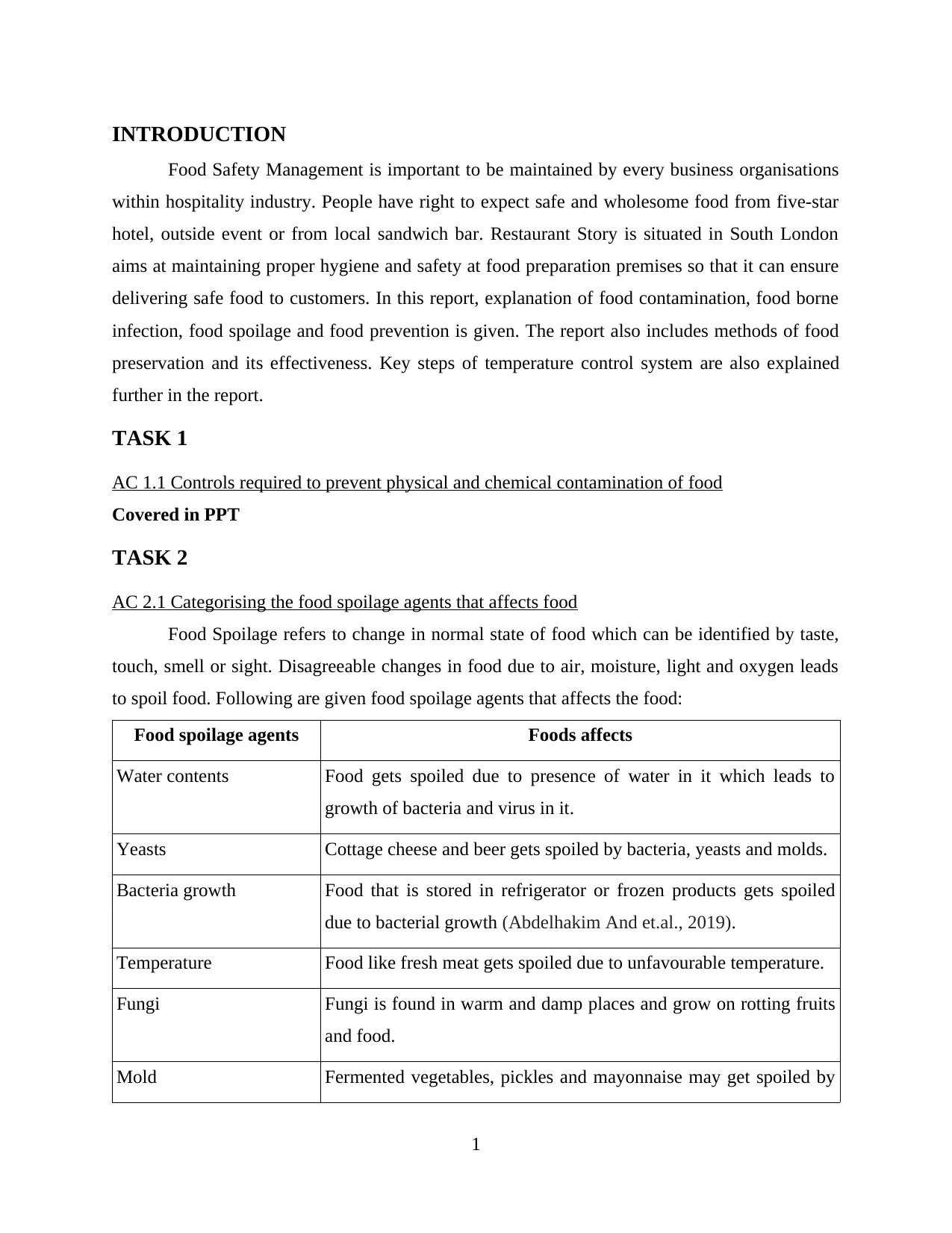
INTRODUCTION
Food Safety Management is important to be maintained by every business organisations
within hospitality industry. People have right to expect safe and wholesome food from five-star
hotel, outside event or from local sandwich bar. Restaurant Story is situated in South London
aims at maintaining proper hygiene and safety at food preparation premises so that it can ensure
delivering safe food to customers. In this report, explanation of food contamination, food borne
infection, food spoilage and food prevention is given. The report also includes methods of food
preservation and its effectiveness. Key steps of temperature control system are also explained
further in the report.
TASK 1
AC 1.1 Controls required to prevent physical and chemical contamination of food
Covered in PPT
TASK 2
AC 2.1 Categorising the food spoilage agents that affects food
Food Spoilage refers to change in normal state of food which can be identified by taste,
touch, smell or sight. Disagreeable changes in food due to air, moisture, light and oxygen leads
to spoil food. Following are given food spoilage agents that affects the food:
Food spoilage agents Foods affects
Water contents Food gets spoiled due to presence of water in it which leads to
growth of bacteria and virus in it.
Yeasts Cottage cheese and beer gets spoiled by bacteria, yeasts and molds.
Bacteria growth Food that is stored in refrigerator or frozen products gets spoiled
due to bacterial growth (Abdelhakim And et.al., 2019).
Temperature Food like fresh meat gets spoiled due to unfavourable temperature.
Fungi Fungi is found in warm and damp places and grow on rotting fruits
and food.
Mold Fermented vegetables, pickles and mayonnaise may get spoiled by
1
Food Safety Management is important to be maintained by every business organisations
within hospitality industry. People have right to expect safe and wholesome food from five-star
hotel, outside event or from local sandwich bar. Restaurant Story is situated in South London
aims at maintaining proper hygiene and safety at food preparation premises so that it can ensure
delivering safe food to customers. In this report, explanation of food contamination, food borne
infection, food spoilage and food prevention is given. The report also includes methods of food
preservation and its effectiveness. Key steps of temperature control system are also explained
further in the report.
TASK 1
AC 1.1 Controls required to prevent physical and chemical contamination of food
Covered in PPT
TASK 2
AC 2.1 Categorising the food spoilage agents that affects food
Food Spoilage refers to change in normal state of food which can be identified by taste,
touch, smell or sight. Disagreeable changes in food due to air, moisture, light and oxygen leads
to spoil food. Following are given food spoilage agents that affects the food:
Food spoilage agents Foods affects
Water contents Food gets spoiled due to presence of water in it which leads to
growth of bacteria and virus in it.
Yeasts Cottage cheese and beer gets spoiled by bacteria, yeasts and molds.
Bacteria growth Food that is stored in refrigerator or frozen products gets spoiled
due to bacterial growth (Abdelhakim And et.al., 2019).
Temperature Food like fresh meat gets spoiled due to unfavourable temperature.
Fungi Fungi is found in warm and damp places and grow on rotting fruits
and food.
Mold Fermented vegetables, pickles and mayonnaise may get spoiled by
1
⊘ This is a preview!⊘
Do you want full access?
Subscribe today to unlock all pages.

Trusted by 1+ million students worldwide
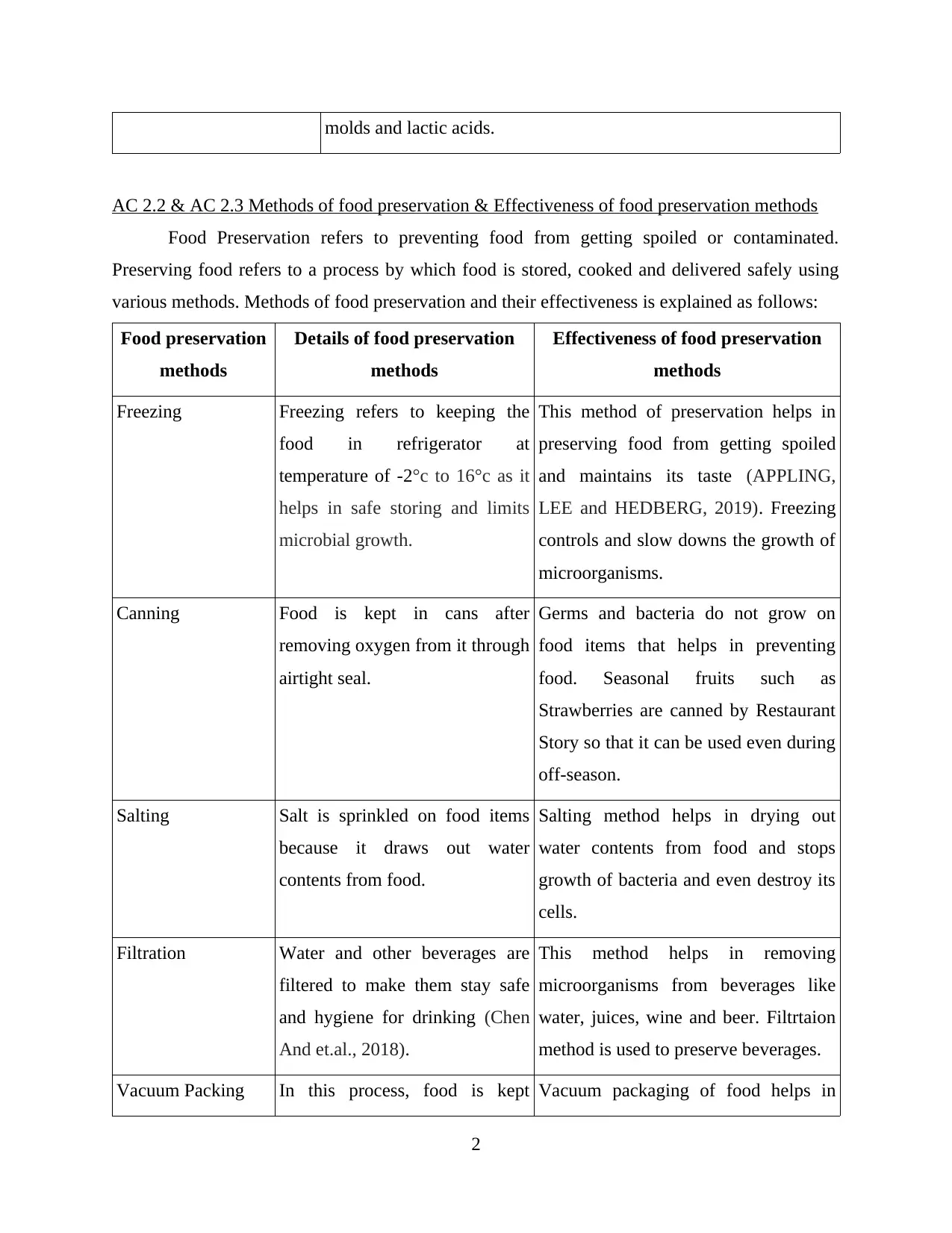
molds and lactic acids.
AC 2.2 & AC 2.3 Methods of food preservation & Effectiveness of food preservation methods
Food Preservation refers to preventing food from getting spoiled or contaminated.
Preserving food refers to a process by which food is stored, cooked and delivered safely using
various methods. Methods of food preservation and their effectiveness is explained as follows:
Food preservation
methods
Details of food preservation
methods
Effectiveness of food preservation
methods
Freezing Freezing refers to keeping the
food in refrigerator at
temperature of -2°c to 16°c as it
helps in safe storing and limits
microbial growth.
This method of preservation helps in
preserving food from getting spoiled
and maintains its taste (APPLING,
LEE and HEDBERG, 2019). Freezing
controls and slow downs the growth of
microorganisms.
Canning Food is kept in cans after
removing oxygen from it through
airtight seal.
Germs and bacteria do not grow on
food items that helps in preventing
food. Seasonal fruits such as
Strawberries are canned by Restaurant
Story so that it can be used even during
off-season.
Salting Salt is sprinkled on food items
because it draws out water
contents from food.
Salting method helps in drying out
water contents from food and stops
growth of bacteria and even destroy its
cells.
Filtration Water and other beverages are
filtered to make them stay safe
and hygiene for drinking (Chen
And et.al., 2018).
This method helps in removing
microorganisms from beverages like
water, juices, wine and beer. Filtrtaion
method is used to preserve beverages.
Vacuum Packing In this process, food is kept Vacuum packaging of food helps in
2
AC 2.2 & AC 2.3 Methods of food preservation & Effectiveness of food preservation methods
Food Preservation refers to preventing food from getting spoiled or contaminated.
Preserving food refers to a process by which food is stored, cooked and delivered safely using
various methods. Methods of food preservation and their effectiveness is explained as follows:
Food preservation
methods
Details of food preservation
methods
Effectiveness of food preservation
methods
Freezing Freezing refers to keeping the
food in refrigerator at
temperature of -2°c to 16°c as it
helps in safe storing and limits
microbial growth.
This method of preservation helps in
preserving food from getting spoiled
and maintains its taste (APPLING,
LEE and HEDBERG, 2019). Freezing
controls and slow downs the growth of
microorganisms.
Canning Food is kept in cans after
removing oxygen from it through
airtight seal.
Germs and bacteria do not grow on
food items that helps in preventing
food. Seasonal fruits such as
Strawberries are canned by Restaurant
Story so that it can be used even during
off-season.
Salting Salt is sprinkled on food items
because it draws out water
contents from food.
Salting method helps in drying out
water contents from food and stops
growth of bacteria and even destroy its
cells.
Filtration Water and other beverages are
filtered to make them stay safe
and hygiene for drinking (Chen
And et.al., 2018).
This method helps in removing
microorganisms from beverages like
water, juices, wine and beer. Filtrtaion
method is used to preserve beverages.
Vacuum Packing In this process, food is kept Vacuum packaging of food helps in
2
Paraphrase This Document
Need a fresh take? Get an instant paraphrase of this document with our AI Paraphraser
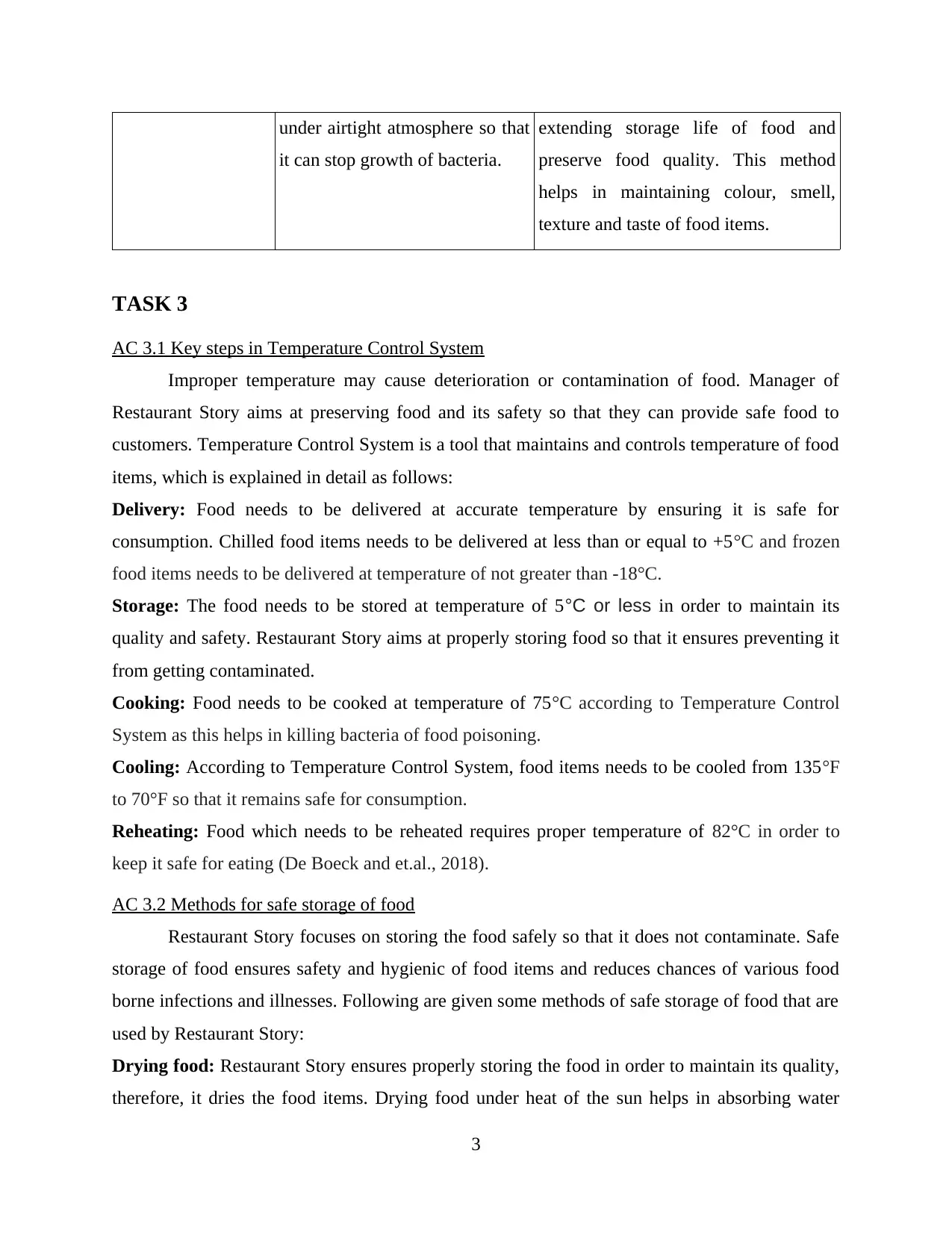
under airtight atmosphere so that
it can stop growth of bacteria.
extending storage life of food and
preserve food quality. This method
helps in maintaining colour, smell,
texture and taste of food items.
TASK 3
AC 3.1 Key steps in Temperature Control System
Improper temperature may cause deterioration or contamination of food. Manager of
Restaurant Story aims at preserving food and its safety so that they can provide safe food to
customers. Temperature Control System is a tool that maintains and controls temperature of food
items, which is explained in detail as follows:
Delivery: Food needs to be delivered at accurate temperature by ensuring it is safe for
consumption. Chilled food items needs to be delivered at less than or equal to +5°C and frozen
food items needs to be delivered at temperature of not greater than -18°C.
Storage: The food needs to be stored at temperature of 5°C or less in order to maintain its
quality and safety. Restaurant Story aims at properly storing food so that it ensures preventing it
from getting contaminated.
Cooking: Food needs to be cooked at temperature of 75°C according to Temperature Control
System as this helps in killing bacteria of food poisoning.
Cooling: According to Temperature Control System, food items needs to be cooled from 135°F
to 70°F so that it remains safe for consumption.
Reheating: Food which needs to be reheated requires proper temperature of 82°C in order to
keep it safe for eating (De Boeck and et.al., 2018).
AC 3.2 Methods for safe storage of food
Restaurant Story focuses on storing the food safely so that it does not contaminate. Safe
storage of food ensures safety and hygienic of food items and reduces chances of various food
borne infections and illnesses. Following are given some methods of safe storage of food that are
used by Restaurant Story:
Drying food: Restaurant Story ensures properly storing the food in order to maintain its quality,
therefore, it dries the food items. Drying food under heat of the sun helps in absorbing water
3
it can stop growth of bacteria.
extending storage life of food and
preserve food quality. This method
helps in maintaining colour, smell,
texture and taste of food items.
TASK 3
AC 3.1 Key steps in Temperature Control System
Improper temperature may cause deterioration or contamination of food. Manager of
Restaurant Story aims at preserving food and its safety so that they can provide safe food to
customers. Temperature Control System is a tool that maintains and controls temperature of food
items, which is explained in detail as follows:
Delivery: Food needs to be delivered at accurate temperature by ensuring it is safe for
consumption. Chilled food items needs to be delivered at less than or equal to +5°C and frozen
food items needs to be delivered at temperature of not greater than -18°C.
Storage: The food needs to be stored at temperature of 5°C or less in order to maintain its
quality and safety. Restaurant Story aims at properly storing food so that it ensures preventing it
from getting contaminated.
Cooking: Food needs to be cooked at temperature of 75°C according to Temperature Control
System as this helps in killing bacteria of food poisoning.
Cooling: According to Temperature Control System, food items needs to be cooled from 135°F
to 70°F so that it remains safe for consumption.
Reheating: Food which needs to be reheated requires proper temperature of 82°C in order to
keep it safe for eating (De Boeck and et.al., 2018).
AC 3.2 Methods for safe storage of food
Restaurant Story focuses on storing the food safely so that it does not contaminate. Safe
storage of food ensures safety and hygienic of food items and reduces chances of various food
borne infections and illnesses. Following are given some methods of safe storage of food that are
used by Restaurant Story:
Drying food: Restaurant Story ensures properly storing the food in order to maintain its quality,
therefore, it dries the food items. Drying food under heat of the sun helps in absorbing water
3
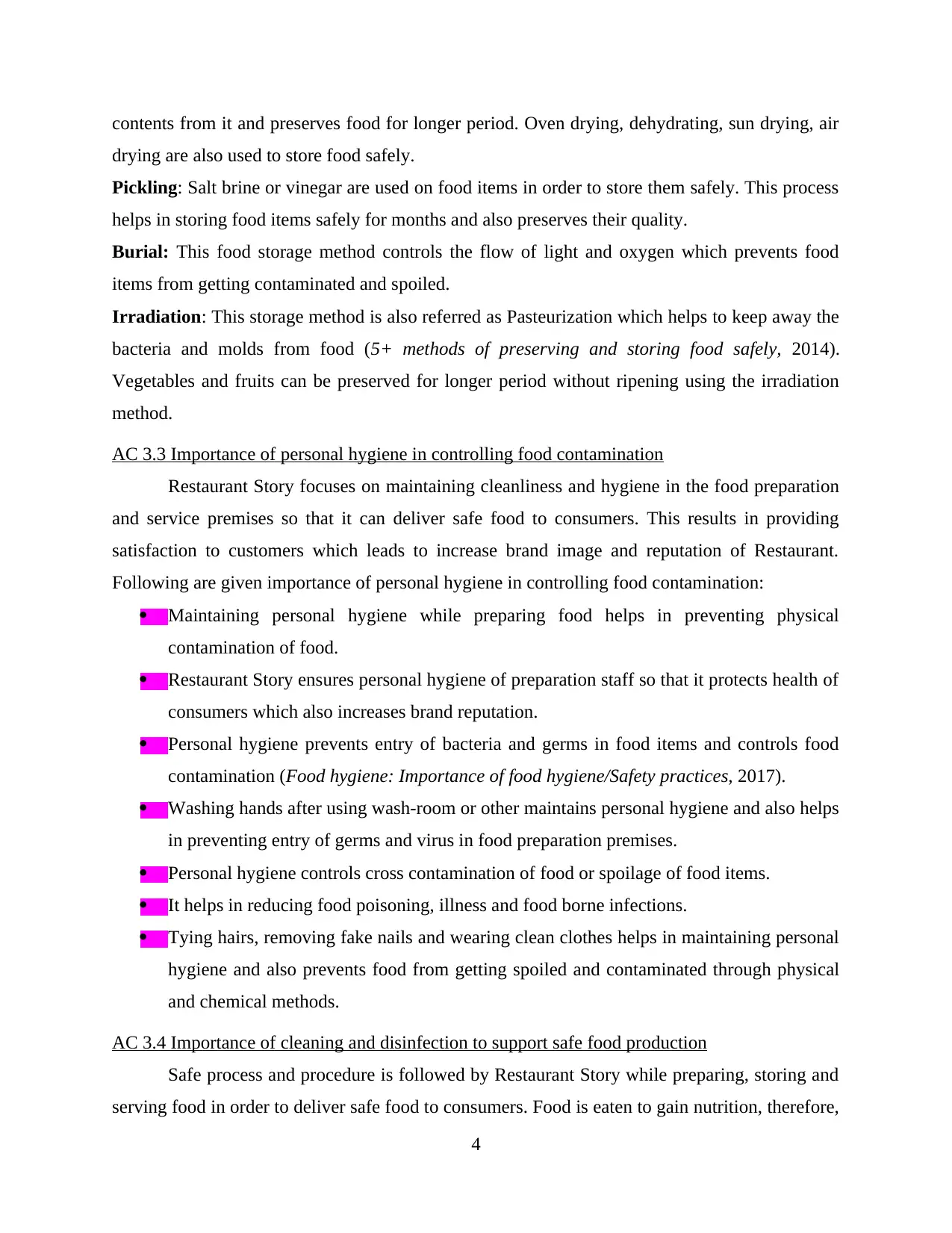
contents from it and preserves food for longer period. Oven drying, dehydrating, sun drying, air
drying are also used to store food safely.
Pickling: Salt brine or vinegar are used on food items in order to store them safely. This process
helps in storing food items safely for months and also preserves their quality.
Burial: This food storage method controls the flow of light and oxygen which prevents food
items from getting contaminated and spoiled.
Irradiation: This storage method is also referred as Pasteurization which helps to keep away the
bacteria and molds from food (5+ methods of preserving and storing food safely, 2014).
Vegetables and fruits can be preserved for longer period without ripening using the irradiation
method.
AC 3.3 Importance of personal hygiene in controlling food contamination
Restaurant Story focuses on maintaining cleanliness and hygiene in the food preparation
and service premises so that it can deliver safe food to consumers. This results in providing
satisfaction to customers which leads to increase brand image and reputation of Restaurant.
Following are given importance of personal hygiene in controlling food contamination:
Maintaining personal hygiene while preparing food helps in preventing physical
contamination of food.
Restaurant Story ensures personal hygiene of preparation staff so that it protects health of
consumers which also increases brand reputation.
Personal hygiene prevents entry of bacteria and germs in food items and controls food
contamination (Food hygiene: Importance of food hygiene/Safety practices, 2017).
Washing hands after using wash-room or other maintains personal hygiene and also helps
in preventing entry of germs and virus in food preparation premises.
Personal hygiene controls cross contamination of food or spoilage of food items.
It helps in reducing food poisoning, illness and food borne infections.
Tying hairs, removing fake nails and wearing clean clothes helps in maintaining personal
hygiene and also prevents food from getting spoiled and contaminated through physical
and chemical methods.
AC 3.4 Importance of cleaning and disinfection to support safe food production
Safe process and procedure is followed by Restaurant Story while preparing, storing and
serving food in order to deliver safe food to consumers. Food is eaten to gain nutrition, therefore,
4
drying are also used to store food safely.
Pickling: Salt brine or vinegar are used on food items in order to store them safely. This process
helps in storing food items safely for months and also preserves their quality.
Burial: This food storage method controls the flow of light and oxygen which prevents food
items from getting contaminated and spoiled.
Irradiation: This storage method is also referred as Pasteurization which helps to keep away the
bacteria and molds from food (5+ methods of preserving and storing food safely, 2014).
Vegetables and fruits can be preserved for longer period without ripening using the irradiation
method.
AC 3.3 Importance of personal hygiene in controlling food contamination
Restaurant Story focuses on maintaining cleanliness and hygiene in the food preparation
and service premises so that it can deliver safe food to consumers. This results in providing
satisfaction to customers which leads to increase brand image and reputation of Restaurant.
Following are given importance of personal hygiene in controlling food contamination:
Maintaining personal hygiene while preparing food helps in preventing physical
contamination of food.
Restaurant Story ensures personal hygiene of preparation staff so that it protects health of
consumers which also increases brand reputation.
Personal hygiene prevents entry of bacteria and germs in food items and controls food
contamination (Food hygiene: Importance of food hygiene/Safety practices, 2017).
Washing hands after using wash-room or other maintains personal hygiene and also helps
in preventing entry of germs and virus in food preparation premises.
Personal hygiene controls cross contamination of food or spoilage of food items.
It helps in reducing food poisoning, illness and food borne infections.
Tying hairs, removing fake nails and wearing clean clothes helps in maintaining personal
hygiene and also prevents food from getting spoiled and contaminated through physical
and chemical methods.
AC 3.4 Importance of cleaning and disinfection to support safe food production
Safe process and procedure is followed by Restaurant Story while preparing, storing and
serving food in order to deliver safe food to consumers. Food is eaten to gain nutrition, therefore,
4
⊘ This is a preview!⊘
Do you want full access?
Subscribe today to unlock all pages.

Trusted by 1+ million students worldwide
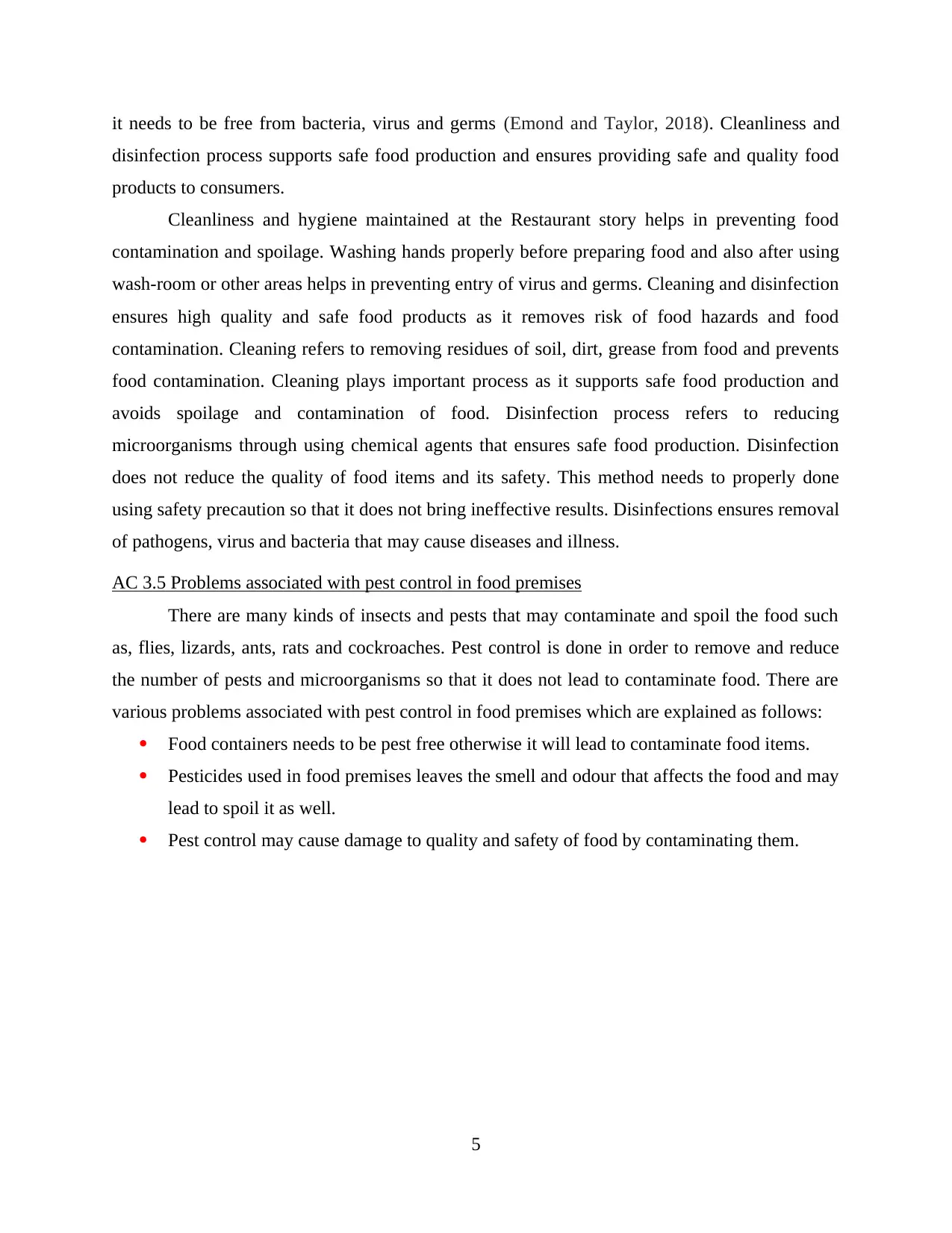
it needs to be free from bacteria, virus and germs (Emond and Taylor, 2018). Cleanliness and
disinfection process supports safe food production and ensures providing safe and quality food
products to consumers.
Cleanliness and hygiene maintained at the Restaurant story helps in preventing food
contamination and spoilage. Washing hands properly before preparing food and also after using
wash-room or other areas helps in preventing entry of virus and germs. Cleaning and disinfection
ensures high quality and safe food products as it removes risk of food hazards and food
contamination. Cleaning refers to removing residues of soil, dirt, grease from food and prevents
food contamination. Cleaning plays important process as it supports safe food production and
avoids spoilage and contamination of food. Disinfection process refers to reducing
microorganisms through using chemical agents that ensures safe food production. Disinfection
does not reduce the quality of food items and its safety. This method needs to properly done
using safety precaution so that it does not bring ineffective results. Disinfections ensures removal
of pathogens, virus and bacteria that may cause diseases and illness.
AC 3.5 Problems associated with pest control in food premises
There are many kinds of insects and pests that may contaminate and spoil the food such
as, flies, lizards, ants, rats and cockroaches. Pest control is done in order to remove and reduce
the number of pests and microorganisms so that it does not lead to contaminate food. There are
various problems associated with pest control in food premises which are explained as follows:
Food containers needs to be pest free otherwise it will lead to contaminate food items.
Pesticides used in food premises leaves the smell and odour that affects the food and may
lead to spoil it as well.
Pest control may cause damage to quality and safety of food by contaminating them.
5
disinfection process supports safe food production and ensures providing safe and quality food
products to consumers.
Cleanliness and hygiene maintained at the Restaurant story helps in preventing food
contamination and spoilage. Washing hands properly before preparing food and also after using
wash-room or other areas helps in preventing entry of virus and germs. Cleaning and disinfection
ensures high quality and safe food products as it removes risk of food hazards and food
contamination. Cleaning refers to removing residues of soil, dirt, grease from food and prevents
food contamination. Cleaning plays important process as it supports safe food production and
avoids spoilage and contamination of food. Disinfection process refers to reducing
microorganisms through using chemical agents that ensures safe food production. Disinfection
does not reduce the quality of food items and its safety. This method needs to properly done
using safety precaution so that it does not bring ineffective results. Disinfections ensures removal
of pathogens, virus and bacteria that may cause diseases and illness.
AC 3.5 Problems associated with pest control in food premises
There are many kinds of insects and pests that may contaminate and spoil the food such
as, flies, lizards, ants, rats and cockroaches. Pest control is done in order to remove and reduce
the number of pests and microorganisms so that it does not lead to contaminate food. There are
various problems associated with pest control in food premises which are explained as follows:
Food containers needs to be pest free otherwise it will lead to contaminate food items.
Pesticides used in food premises leaves the smell and odour that affects the food and may
lead to spoil it as well.
Pest control may cause damage to quality and safety of food by contaminating them.
5
Paraphrase This Document
Need a fresh take? Get an instant paraphrase of this document with our AI Paraphraser

Pest control used in food preparation premises may cause chemical contamination of food
(Granados, Pérez and Valero, 2018).
Pesticides kept in food preparation premises may also lead to contaminate or spoil the
food therefore it needs to be kept away from food preparing area.
AC 3.6 Need for hygiene design and construction of food premises
Restaurant Story aims at maintaining cleanliness and hygiene so that it can provide safe
and quality food products to consumers (Manning, 2018). Hygiene design and construction helps
in maintaining cleanliness and also prevent food from getting contaminated or spoiled.
Hygiene design and construction of food premises allows staff of Restaurant to clean
premises easily and stops building up of toxic material and dirt.
Hygiene design and construction in Restaurant Story prevents food contamination due to
pest control as proper guidelines are followed.
Effective drainage is facilitated under hygiene design that allows easy removal of
wastage without contaminating or affecting food items.
Hygiene design and construction facilitates creating trust and image in the minds of
customers.
Hygiene design and construction of food premises allows keeping out dust, smoke and
dirt away from food items and prevents physical and chemical food contamination.
Hygiene design and construction refers to premises free from pest and pesticides that
leads to make food safe for consumption.
AC 3.7 Importance of training as a Quality Assurance Mechanism
Hygiene training regarding quality assurance mechanisms helps in preventing defects and
mistakes while preparing food items and also avoiding problems while delivering services to
consumers (Marriott, Schilling and Gravani, 2018). Quality assurance mechanism ensures that
quality standards and safety of food products are maintained. Restaurant Story aims at providing
quality services to consumers, therefore, it provides training to its employees and staff.
Following are given some importance of training as a quality assurance mechanism:
Training ensures that employees have proper and adequate knowledge of maintaining
safety and quality of food products.
Training also ensures that there is minimum or no wastage of products because products
are checked properly at every stage.
6
(Granados, Pérez and Valero, 2018).
Pesticides kept in food preparation premises may also lead to contaminate or spoil the
food therefore it needs to be kept away from food preparing area.
AC 3.6 Need for hygiene design and construction of food premises
Restaurant Story aims at maintaining cleanliness and hygiene so that it can provide safe
and quality food products to consumers (Manning, 2018). Hygiene design and construction helps
in maintaining cleanliness and also prevent food from getting contaminated or spoiled.
Hygiene design and construction of food premises allows staff of Restaurant to clean
premises easily and stops building up of toxic material and dirt.
Hygiene design and construction in Restaurant Story prevents food contamination due to
pest control as proper guidelines are followed.
Effective drainage is facilitated under hygiene design that allows easy removal of
wastage without contaminating or affecting food items.
Hygiene design and construction facilitates creating trust and image in the minds of
customers.
Hygiene design and construction of food premises allows keeping out dust, smoke and
dirt away from food items and prevents physical and chemical food contamination.
Hygiene design and construction refers to premises free from pest and pesticides that
leads to make food safe for consumption.
AC 3.7 Importance of training as a Quality Assurance Mechanism
Hygiene training regarding quality assurance mechanisms helps in preventing defects and
mistakes while preparing food items and also avoiding problems while delivering services to
consumers (Marriott, Schilling and Gravani, 2018). Quality assurance mechanism ensures that
quality standards and safety of food products are maintained. Restaurant Story aims at providing
quality services to consumers, therefore, it provides training to its employees and staff.
Following are given some importance of training as a quality assurance mechanism:
Training ensures that employees have proper and adequate knowledge of maintaining
safety and quality of food products.
Training also ensures that there is minimum or no wastage of products because products
are checked properly at every stage.
6

Quality assurance mechanisms helps in improving performance of employees and staff
because they aim at maintaining quality and safety of food items.
This provides benefits of reducing waste and cost as it faulty and defects process are
removed (Quality Assurance, 2018).
This leads to create well-organized team who together focuses on providing quality
services to final customers.
TASK 4
AC 4.1 A food hazard risk assessment
Restaurant Story focuses on maintaining food safety and quality in order to provide
quality product and services to customers. Therefore, Restaurant produces a risk hazard
assessment for identifying major factors of risk hazards and also finds controls for preventing
them.
Hazards encountered in
food preparation and
serving areas
Risk of hazards Controls to prevent risk
Biological hazards: Food
containing virus, parasites
and bacteria (Njage And
et.al., 2018).
This leads to make food
contaminated. Food borne illness
and infection can be caused by
consuming food with biological
hazards.
Properly handling the food in
both food preparation and
serving areas, cooking food at
accurate temperature and
storing food properly helps in
preventing food from
biological hazards.
Physical hazards: Food
with false nails, hairs,
glass, metal, pieces of
jewellery or metal
fragments.
Physical hazards encountered in
food or food premises leads to spoil
and contaminate the food. Eating
contaminated food makes person
sick and also suffers from nausea,
vomiting and abdominal pain.
Properly tying hair, removing
jewellery and fake nails while
preparing food will prevent
physical hazards.
Chemical hazards: Food Eating and consuming food with Toxic and harmful pesticides
7
because they aim at maintaining quality and safety of food items.
This provides benefits of reducing waste and cost as it faulty and defects process are
removed (Quality Assurance, 2018).
This leads to create well-organized team who together focuses on providing quality
services to final customers.
TASK 4
AC 4.1 A food hazard risk assessment
Restaurant Story focuses on maintaining food safety and quality in order to provide
quality product and services to customers. Therefore, Restaurant produces a risk hazard
assessment for identifying major factors of risk hazards and also finds controls for preventing
them.
Hazards encountered in
food preparation and
serving areas
Risk of hazards Controls to prevent risk
Biological hazards: Food
containing virus, parasites
and bacteria (Njage And
et.al., 2018).
This leads to make food
contaminated. Food borne illness
and infection can be caused by
consuming food with biological
hazards.
Properly handling the food in
both food preparation and
serving areas, cooking food at
accurate temperature and
storing food properly helps in
preventing food from
biological hazards.
Physical hazards: Food
with false nails, hairs,
glass, metal, pieces of
jewellery or metal
fragments.
Physical hazards encountered in
food or food premises leads to spoil
and contaminate the food. Eating
contaminated food makes person
sick and also suffers from nausea,
vomiting and abdominal pain.
Properly tying hair, removing
jewellery and fake nails while
preparing food will prevent
physical hazards.
Chemical hazards: Food Eating and consuming food with Toxic and harmful pesticides
7
⊘ This is a preview!⊘
Do you want full access?
Subscribe today to unlock all pages.

Trusted by 1+ million students worldwide
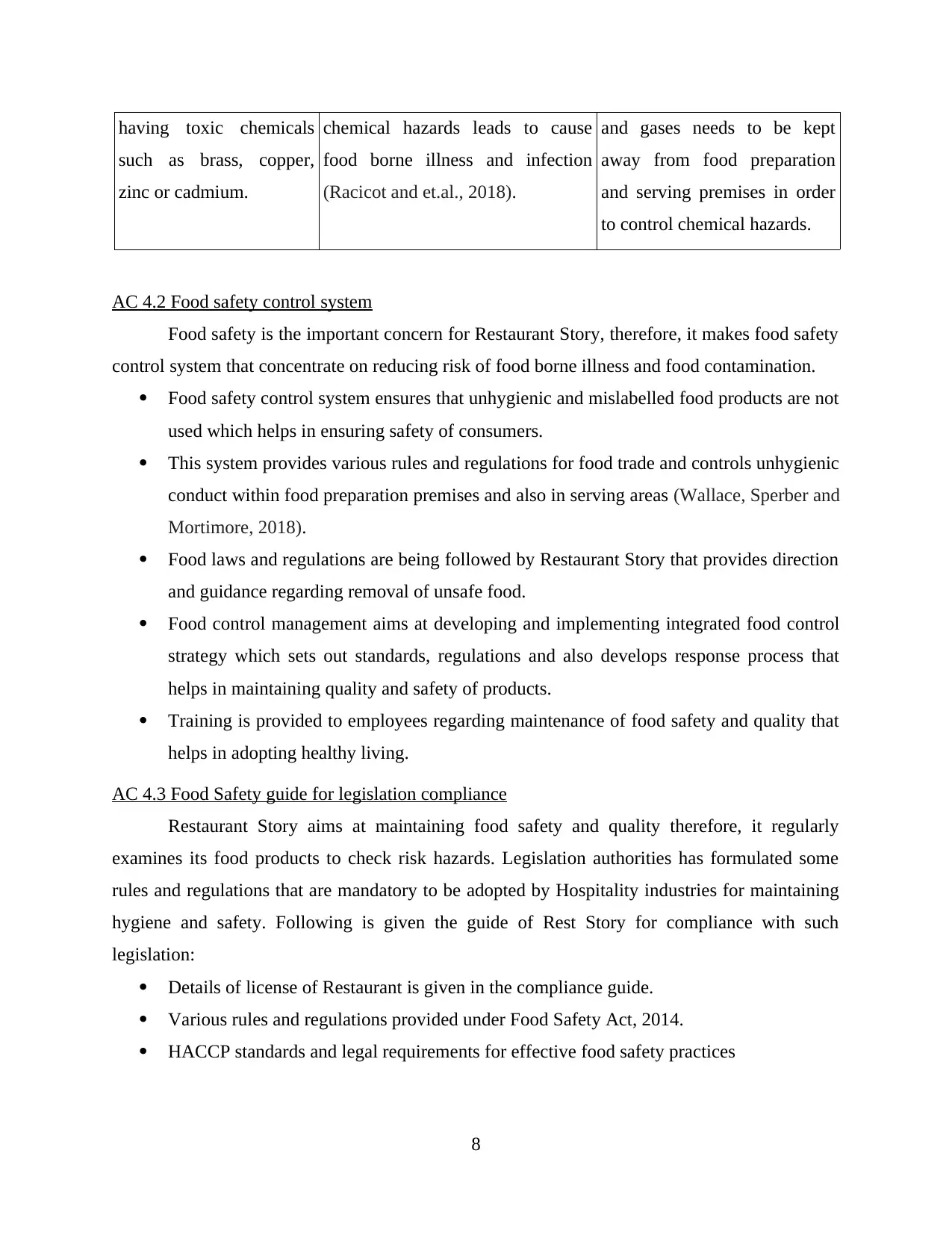
having toxic chemicals
such as brass, copper,
zinc or cadmium.
chemical hazards leads to cause
food borne illness and infection
(Racicot and et.al., 2018).
and gases needs to be kept
away from food preparation
and serving premises in order
to control chemical hazards.
AC 4.2 Food safety control system
Food safety is the important concern for Restaurant Story, therefore, it makes food safety
control system that concentrate on reducing risk of food borne illness and food contamination.
Food safety control system ensures that unhygienic and mislabelled food products are not
used which helps in ensuring safety of consumers.
This system provides various rules and regulations for food trade and controls unhygienic
conduct within food preparation premises and also in serving areas (Wallace, Sperber and
Mortimore, 2018).
Food laws and regulations are being followed by Restaurant Story that provides direction
and guidance regarding removal of unsafe food.
Food control management aims at developing and implementing integrated food control
strategy which sets out standards, regulations and also develops response process that
helps in maintaining quality and safety of products.
Training is provided to employees regarding maintenance of food safety and quality that
helps in adopting healthy living.
AC 4.3 Food Safety guide for legislation compliance
Restaurant Story aims at maintaining food safety and quality therefore, it regularly
examines its food products to check risk hazards. Legislation authorities has formulated some
rules and regulations that are mandatory to be adopted by Hospitality industries for maintaining
hygiene and safety. Following is given the guide of Rest Story for compliance with such
legislation:
Details of license of Restaurant is given in the compliance guide.
Various rules and regulations provided under Food Safety Act, 2014.
HACCP standards and legal requirements for effective food safety practices
8
such as brass, copper,
zinc or cadmium.
chemical hazards leads to cause
food borne illness and infection
(Racicot and et.al., 2018).
and gases needs to be kept
away from food preparation
and serving premises in order
to control chemical hazards.
AC 4.2 Food safety control system
Food safety is the important concern for Restaurant Story, therefore, it makes food safety
control system that concentrate on reducing risk of food borne illness and food contamination.
Food safety control system ensures that unhygienic and mislabelled food products are not
used which helps in ensuring safety of consumers.
This system provides various rules and regulations for food trade and controls unhygienic
conduct within food preparation premises and also in serving areas (Wallace, Sperber and
Mortimore, 2018).
Food laws and regulations are being followed by Restaurant Story that provides direction
and guidance regarding removal of unsafe food.
Food control management aims at developing and implementing integrated food control
strategy which sets out standards, regulations and also develops response process that
helps in maintaining quality and safety of products.
Training is provided to employees regarding maintenance of food safety and quality that
helps in adopting healthy living.
AC 4.3 Food Safety guide for legislation compliance
Restaurant Story aims at maintaining food safety and quality therefore, it regularly
examines its food products to check risk hazards. Legislation authorities has formulated some
rules and regulations that are mandatory to be adopted by Hospitality industries for maintaining
hygiene and safety. Following is given the guide of Rest Story for compliance with such
legislation:
Details of license of Restaurant is given in the compliance guide.
Various rules and regulations provided under Food Safety Act, 2014.
HACCP standards and legal requirements for effective food safety practices
8
Paraphrase This Document
Need a fresh take? Get an instant paraphrase of this document with our AI Paraphraser
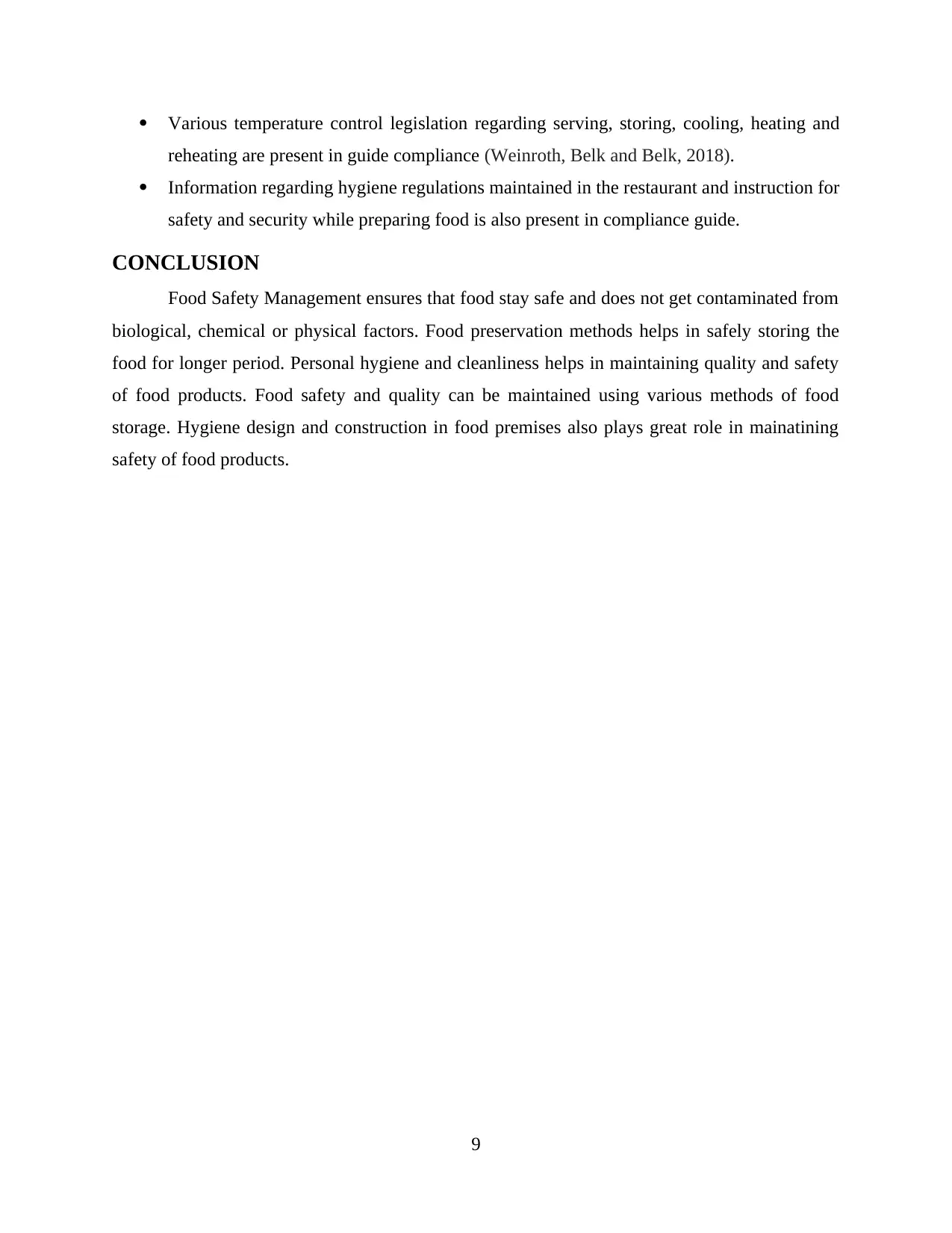
Various temperature control legislation regarding serving, storing, cooling, heating and
reheating are present in guide compliance (Weinroth, Belk and Belk, 2018).
Information regarding hygiene regulations maintained in the restaurant and instruction for
safety and security while preparing food is also present in compliance guide.
CONCLUSION
Food Safety Management ensures that food stay safe and does not get contaminated from
biological, chemical or physical factors. Food preservation methods helps in safely storing the
food for longer period. Personal hygiene and cleanliness helps in maintaining quality and safety
of food products. Food safety and quality can be maintained using various methods of food
storage. Hygiene design and construction in food premises also plays great role in mainatining
safety of food products.
9
reheating are present in guide compliance (Weinroth, Belk and Belk, 2018).
Information regarding hygiene regulations maintained in the restaurant and instruction for
safety and security while preparing food is also present in compliance guide.
CONCLUSION
Food Safety Management ensures that food stay safe and does not get contaminated from
biological, chemical or physical factors. Food preservation methods helps in safely storing the
food for longer period. Personal hygiene and cleanliness helps in maintaining quality and safety
of food products. Food safety and quality can be maintained using various methods of food
storage. Hygiene design and construction in food premises also plays great role in mainatining
safety of food products.
9

REFERENCES
Books And Journal
Abdelhakim, A. S. And et.al., 2019. Cabin crew food safety training: A qualitative study. Food
Control. 96. pp.151-157.
APPLING, X. S., LEE, P. and HEDBERG, C. W., 2019. Understanding the Relation between
Establishment Food Safety Management and Salmonella Risk Factor Violations Cited
during Routine Inspections. Journal of food protection. 82(2). pp.339-343.
Buchanan, R. L. and et.al., 2018. Microorganisms in Foods 7: Microbiological Testing in Food
Safety Management.
Chen, Y. H. And et.al., 2018. Effects of input capacity constraints on food quality and regulation
mechanism design for food safety management. Ecological Modelling. 385. pp.89-95.
De Boeck, E. and et.al., 2018. Quantitative study of food safety climate in Belgian food
processing companies in view of their organizational characteristics. Food control. 88.
pp.15-27.
Emond, B. and Taylor, J. Z., 2018. The importance of measuring food safety and quality culture:
results from a global training survey. Worldwide Hospitality and Tourism Themes. 10(3).
pp.369-375.
Granados, L. R., Pérez, F. and Valero, A., 2018. Food Quality Management Systems in the Dairy
Industry: A Case Study on the Application of Predictive Microbiology in the Microbial
Quality of Milk. In Technological Approaches for Novel Applications in Dairy
Processing. IntechOpen.
Manning, L., 2018. The value of food safety culture to the hospitality industry. Worldwide
Hospitality and Tourism Themes. 10(3). pp.284-296.
Marriott, N. G., Schilling, M. W. and Gravani, R. B., 2018. Principles of food sanitation.
Springer.
Njage, P. M. K. And et.al., 2018. Scale of production and implementation of food safety
programs influence the performance of current food safety management systems: case of
dairy processors. Food Control. 85. pp.85-97.
Racicot, M. and et.al., 2018. Identification of risk factors to be considered for food
establishments’ risk assessment models. Microbial Risk Analysis.
10
Books And Journal
Abdelhakim, A. S. And et.al., 2019. Cabin crew food safety training: A qualitative study. Food
Control. 96. pp.151-157.
APPLING, X. S., LEE, P. and HEDBERG, C. W., 2019. Understanding the Relation between
Establishment Food Safety Management and Salmonella Risk Factor Violations Cited
during Routine Inspections. Journal of food protection. 82(2). pp.339-343.
Buchanan, R. L. and et.al., 2018. Microorganisms in Foods 7: Microbiological Testing in Food
Safety Management.
Chen, Y. H. And et.al., 2018. Effects of input capacity constraints on food quality and regulation
mechanism design for food safety management. Ecological Modelling. 385. pp.89-95.
De Boeck, E. and et.al., 2018. Quantitative study of food safety climate in Belgian food
processing companies in view of their organizational characteristics. Food control. 88.
pp.15-27.
Emond, B. and Taylor, J. Z., 2018. The importance of measuring food safety and quality culture:
results from a global training survey. Worldwide Hospitality and Tourism Themes. 10(3).
pp.369-375.
Granados, L. R., Pérez, F. and Valero, A., 2018. Food Quality Management Systems in the Dairy
Industry: A Case Study on the Application of Predictive Microbiology in the Microbial
Quality of Milk. In Technological Approaches for Novel Applications in Dairy
Processing. IntechOpen.
Manning, L., 2018. The value of food safety culture to the hospitality industry. Worldwide
Hospitality and Tourism Themes. 10(3). pp.284-296.
Marriott, N. G., Schilling, M. W. and Gravani, R. B., 2018. Principles of food sanitation.
Springer.
Njage, P. M. K. And et.al., 2018. Scale of production and implementation of food safety
programs influence the performance of current food safety management systems: case of
dairy processors. Food Control. 85. pp.85-97.
Racicot, M. and et.al., 2018. Identification of risk factors to be considered for food
establishments’ risk assessment models. Microbial Risk Analysis.
10
⊘ This is a preview!⊘
Do you want full access?
Subscribe today to unlock all pages.

Trusted by 1+ million students worldwide
1 out of 13
Related Documents
Your All-in-One AI-Powered Toolkit for Academic Success.
+13062052269
info@desklib.com
Available 24*7 on WhatsApp / Email
![[object Object]](/_next/static/media/star-bottom.7253800d.svg)
Unlock your academic potential
Copyright © 2020–2026 A2Z Services. All Rights Reserved. Developed and managed by ZUCOL.





